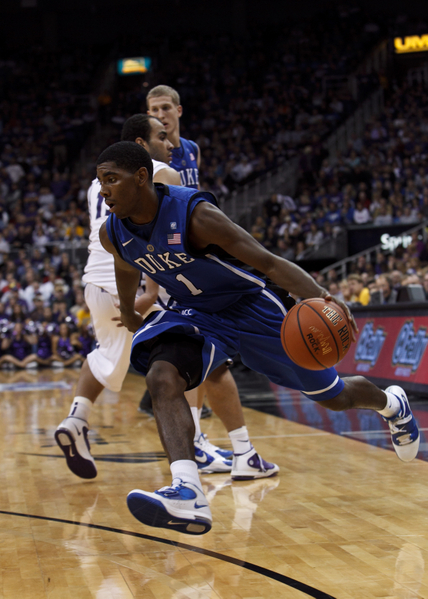Past Imperfect: Major Losses, Mixed Results
Posted by JWeill on January 20th, 2011Past Imperfect is a new series focusing on the history of the game. Every Thursday, RTC contributor JL Weill (@AgonicaBoss) highlights some piece of historical arcana that may (or may not) be relevant to today’s college basketball landscape. This week: How teams over college basketball history have dealt with seemingly devastating injuries to star players. The answer? It depends …
When freshman Duke point guard Kyrie Irving came down awkwardly in a game against Butler with what was a then-seemingly innocuous injury to his toe, the entire landscape of this college hoops season was altered, perhaps irrevocably. Up to that point, there was little disputing who was the 2010-11 college basketball favorite. Not only was Duke the defending NCAA champion, it also returned most of the firepower from that title-winning side as well as adding the nation’s top point guard prospect in New Jersey’s Irving, at a position that was previously the only real soft spot on the Blue Devils roster. With Irving out indefinitely, gone was the swagger of invincibility Duke had in droves in the early weeks of the season. Gone, too, was the sheer talent and ability of Irving, who had earned his accolades and then some with his performance in the season’s first eight games. Irving had saved Duke with 31 points in a win over Michigan State at Cameron Indoor and had reached double figures in points in all of his few games as a collegian. Of course, Purdue would have gladly taken even eight games from its star, Robbie Hummel. Already rehabbing a rebuilt knee from an injury last season, Hummel lasted all of a practice and a half before coming down in a heap after blowing out the same knee. A trendy preseason Final Four pick, Purdue was left without its senior leader and second-leading returning scorer before the season had really even begun.
It remains to be seen whether Duke will shake off the likely loss of Irving’s freshman season and make a run to a second straight title or whether Purdue can find among the guys remaining the makings of a Final Four contender. Both teams have talent on the roster, if not replacements exactly. Teams in the situation Duke and Purdue find themselves in have historically had mixed results recovering. For every championship-caliber team to overcome a major personnel loss to injury there is one for whom the absence of a star player was devastating to its long-term NCAA hopes. Much of that, it turns out upon review, is related to the timing of the injury, as well as just how crucial a role the injured player played on his team. For some squads, losing a player at midseason turned out to be, while never preferred, preferable to losing him just before or during March. For others, losing an on-court presence isn’t as much an issue as losing the club’s emotional leader.
In February of 1997, Rick Pitino’s defending national champion Kentucky Wildcats were ranked fifth in the nation, riding the stellar play of dynamic scoring wings Ron Mercer and Derek Anderson to a 15-2 record heading into a seemingly innocuous game against an overmatched Auburn team at Rupp Arena. At the time, Mercer and Anderson were the most explosive 1-2 combination in America. Then, during the game, Anderson twisted his knee awkwardly on a break and tore his ACL, effectively ending his career as a Wildcat. “It’s like it’s October 15 again as far as our offensive execution is concerned,” Pitino said a few weeks later. But partly because of roster depth and partly because they had time to work around Anderson’s absence, the Wildcats regrouped and managed only three more losses the rest of the season, the final one coming in a classic overtime NCAA championship game vs. Arizona. Anderson returned for just one brief moment, sinking a pair of free throws in zero minutes played in a Final Four win over Minnesota. Kentucky fans still maintain that had Pitino played Anderson even a few minutes in the final, the Wildcats would have taken the title.











































